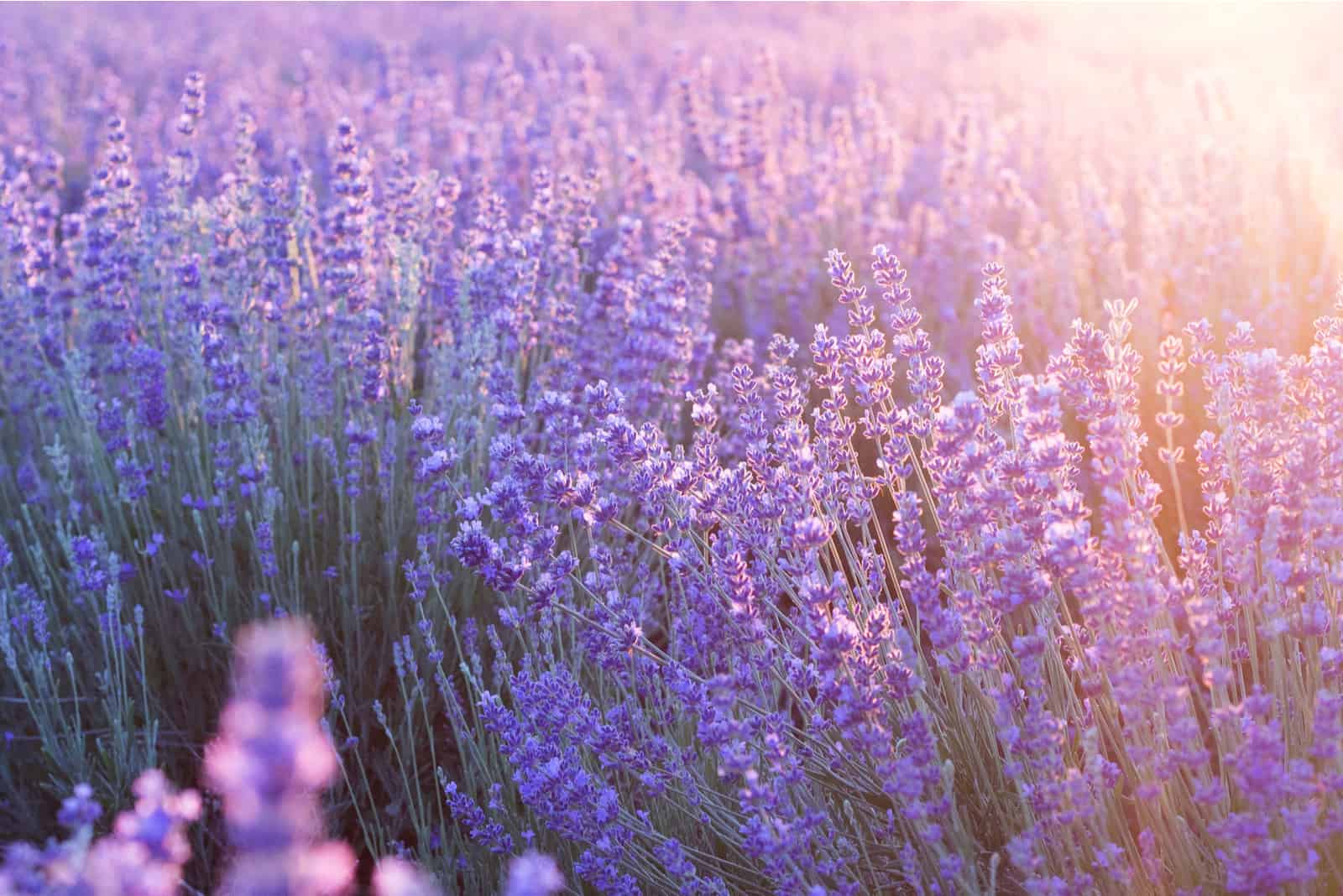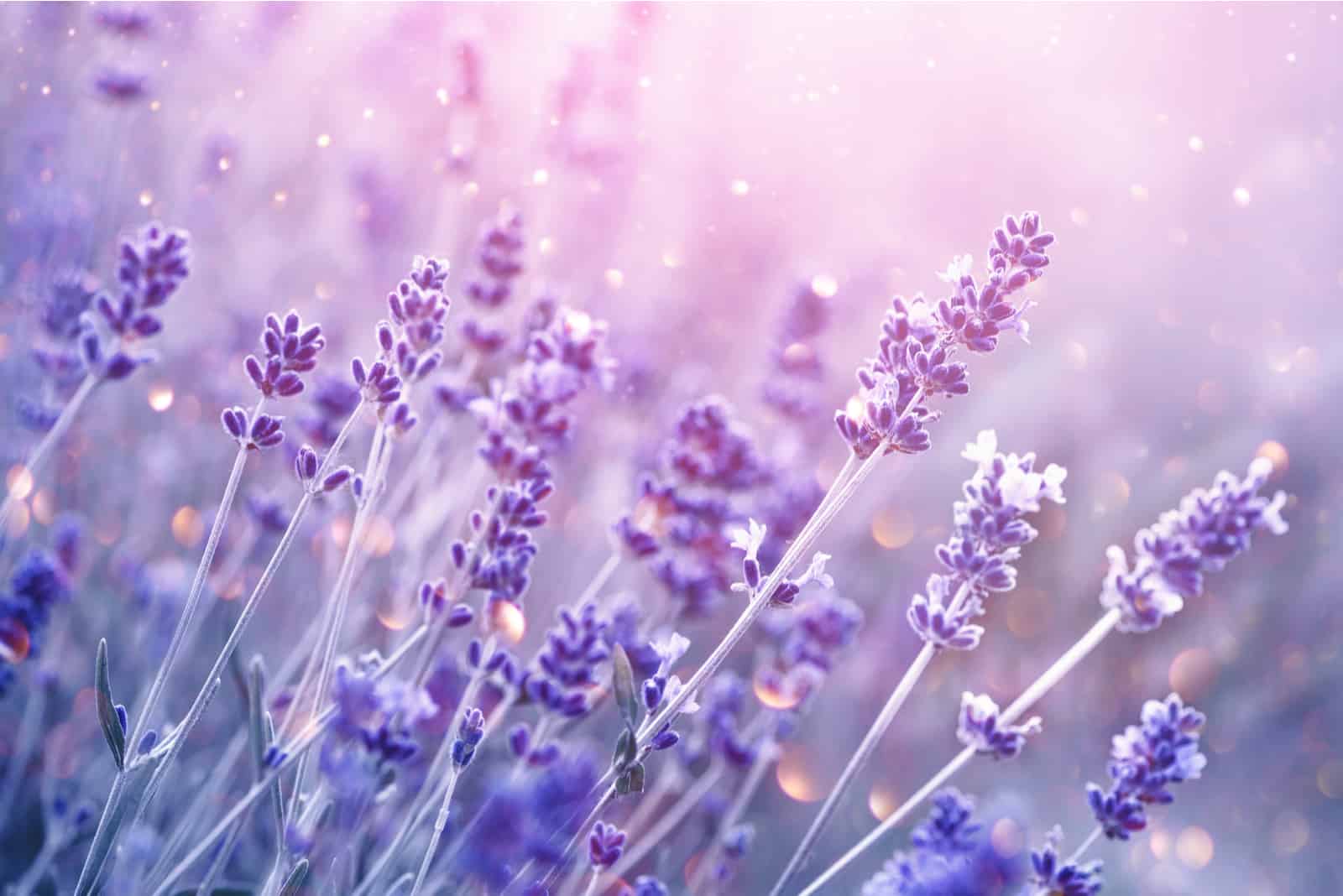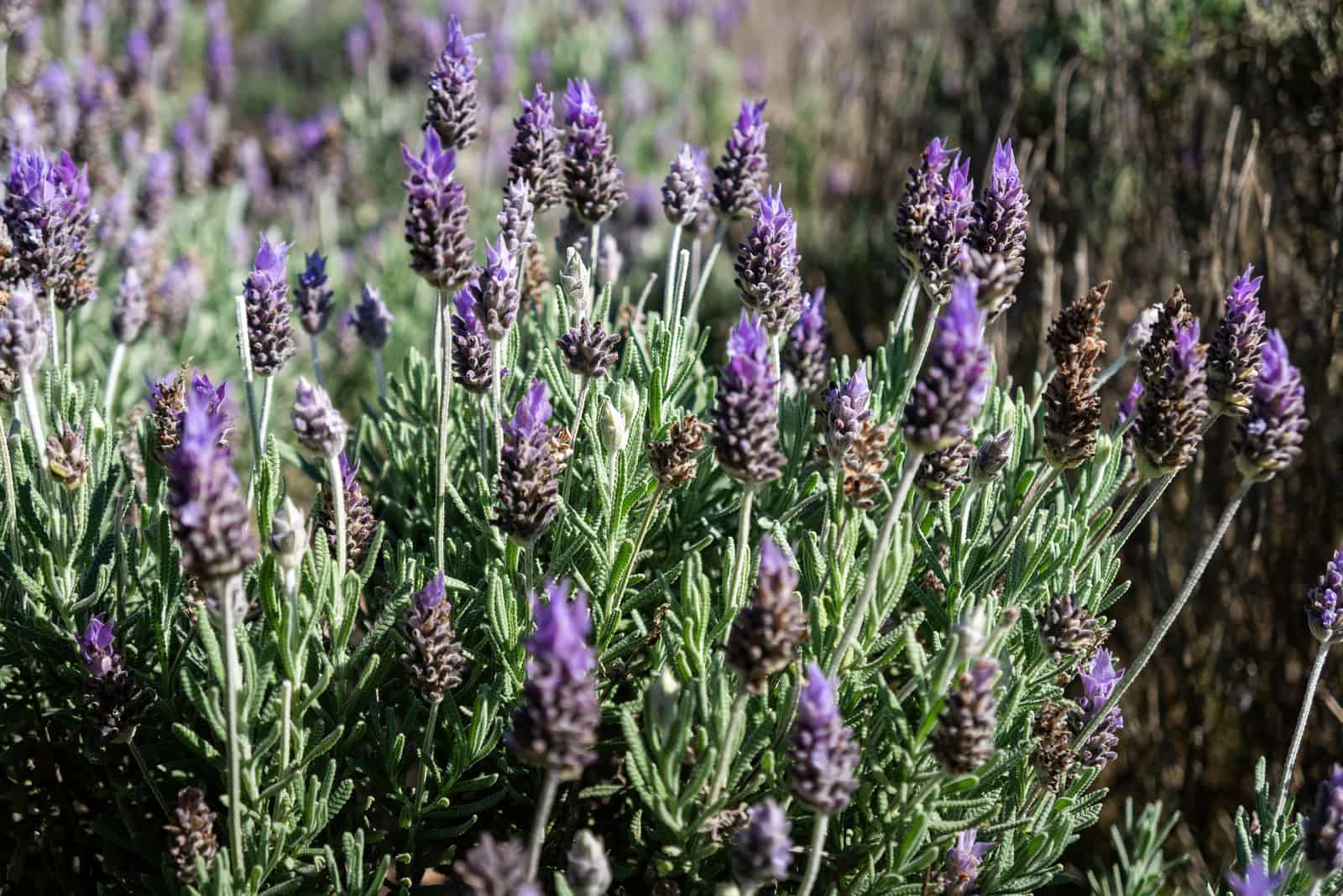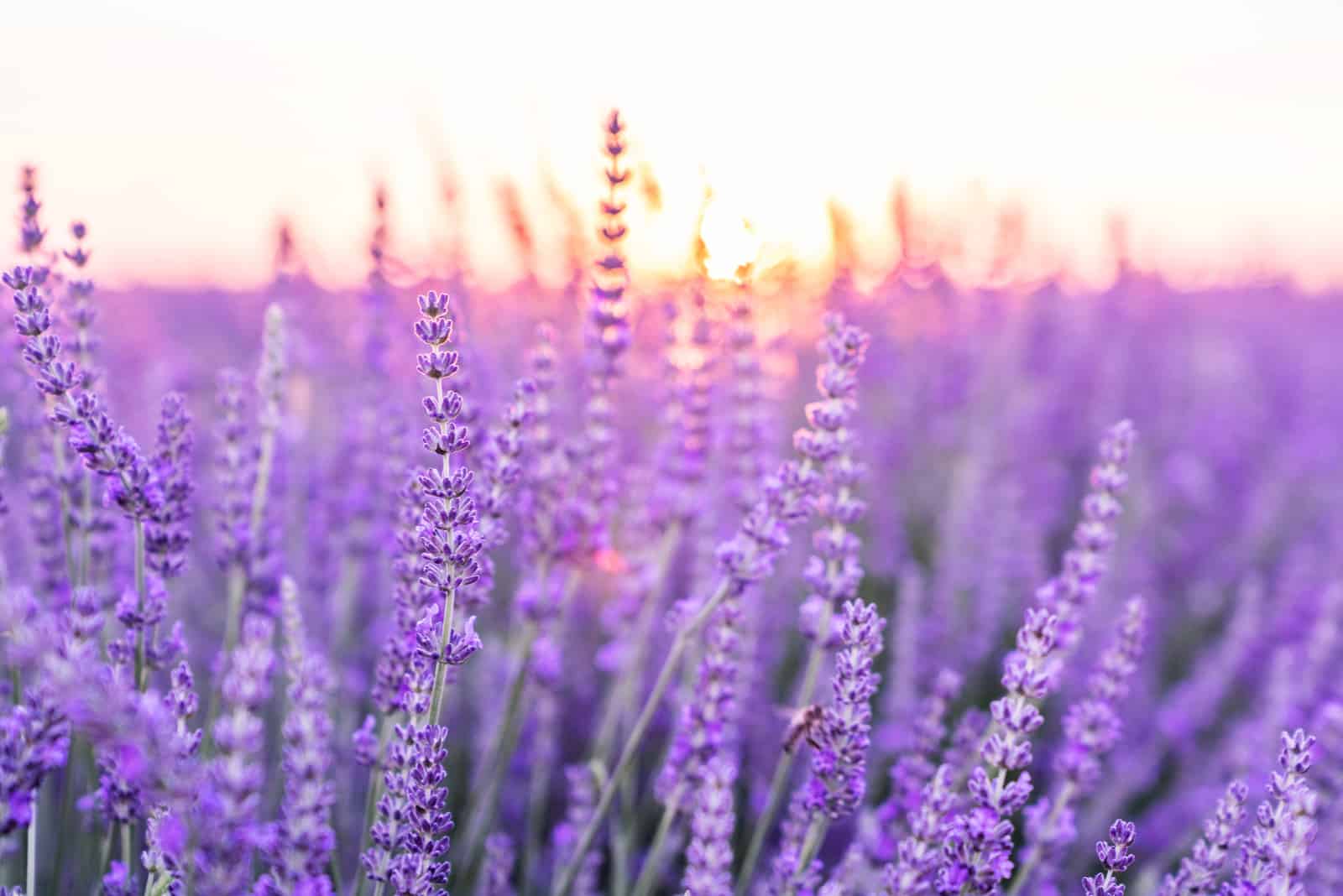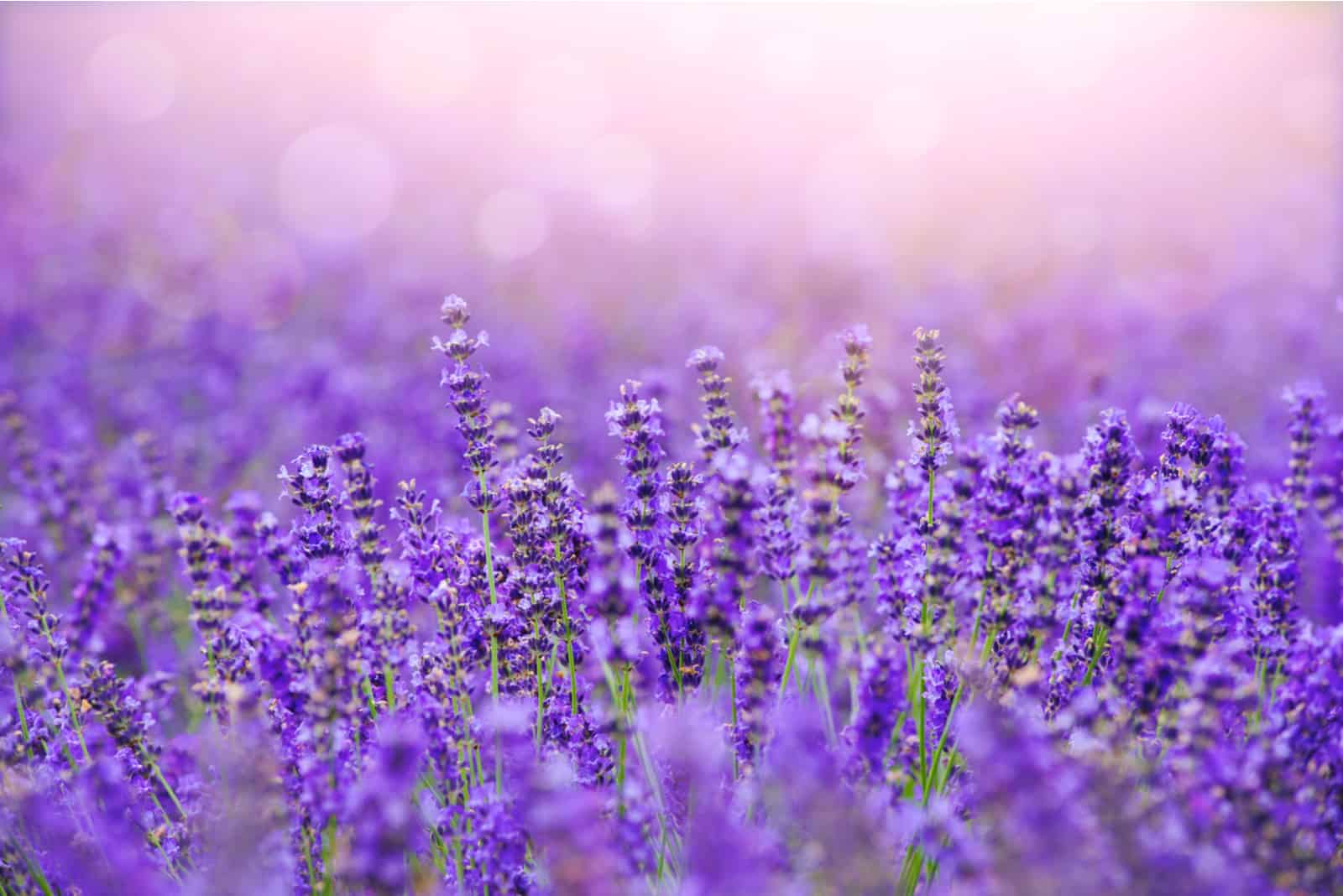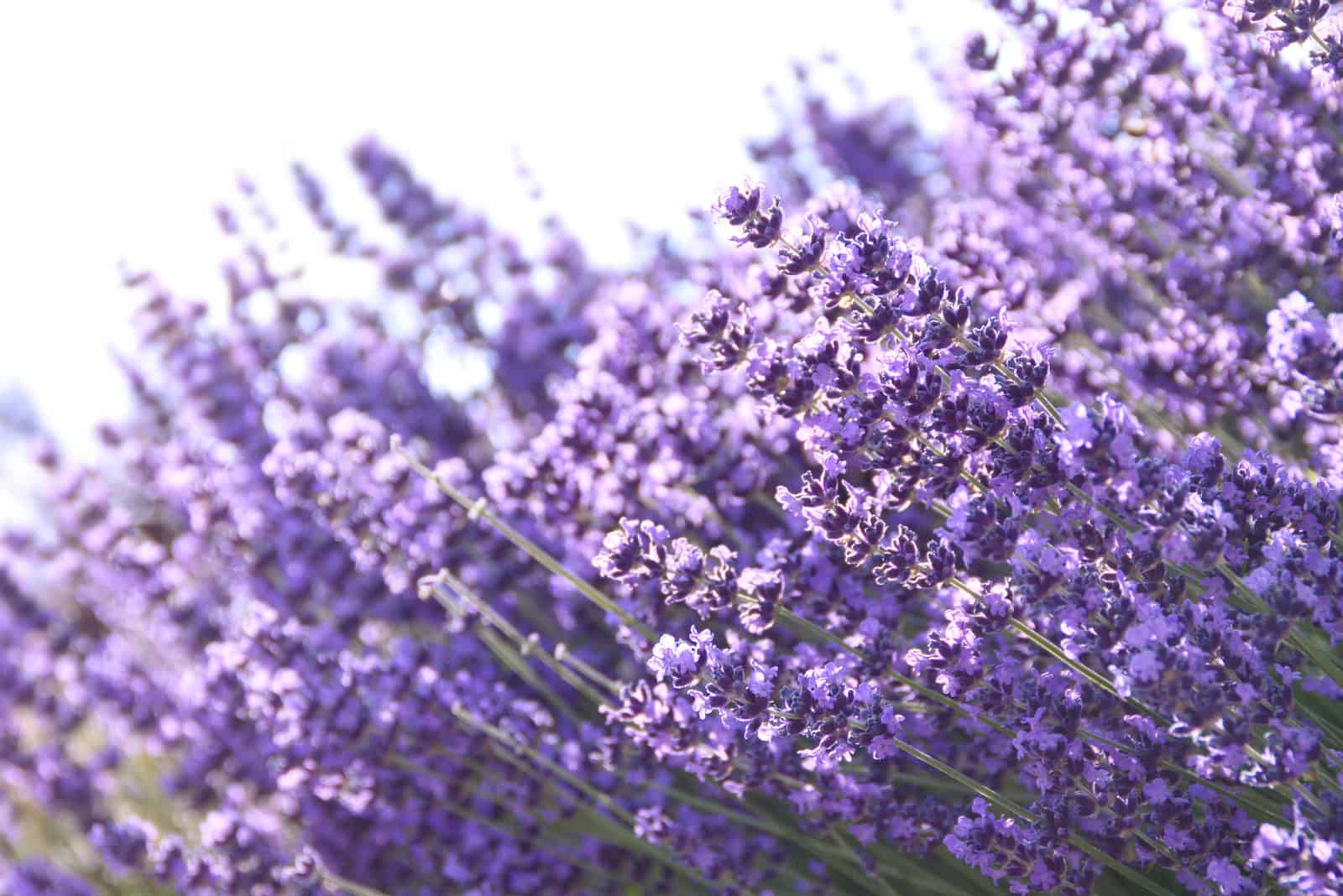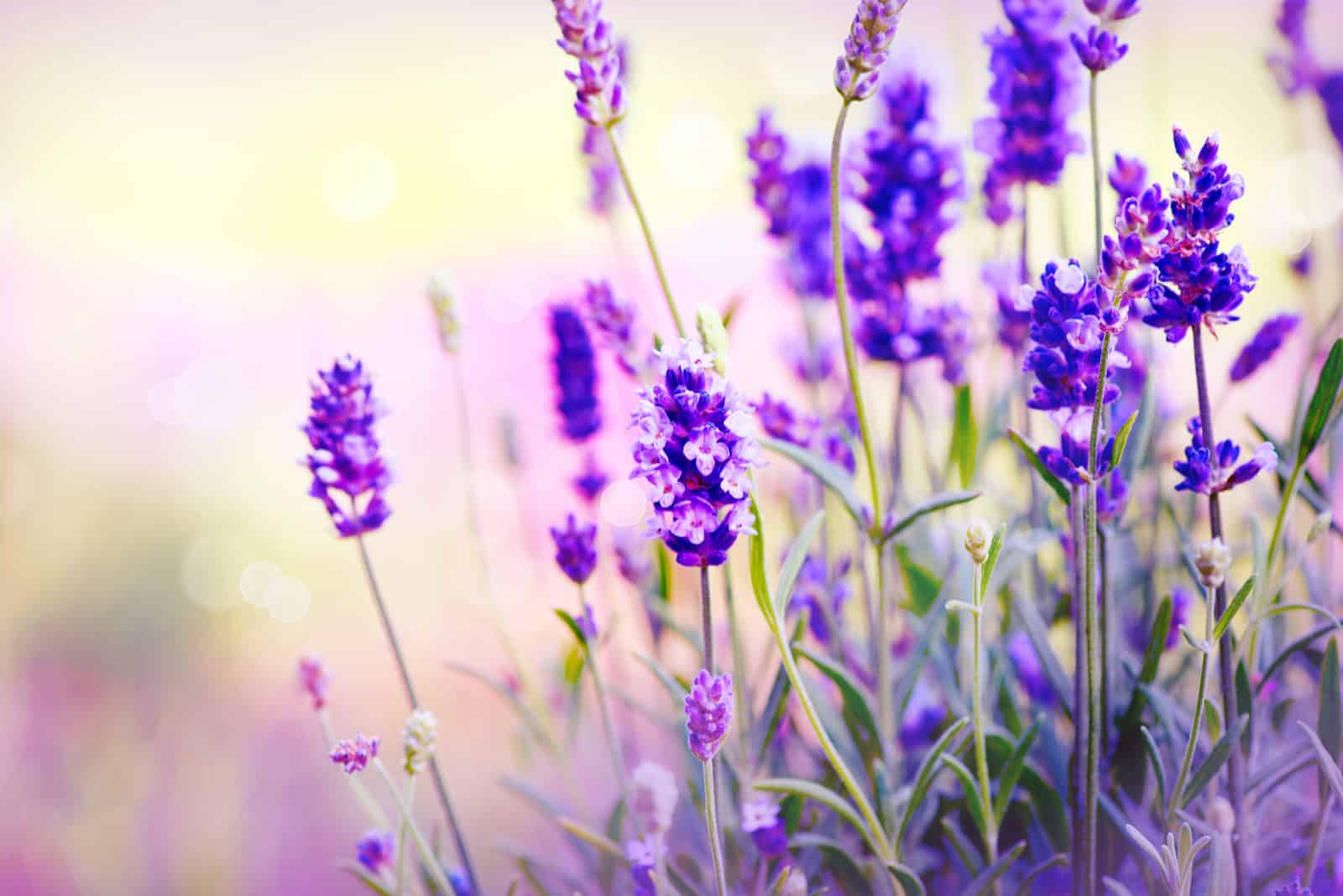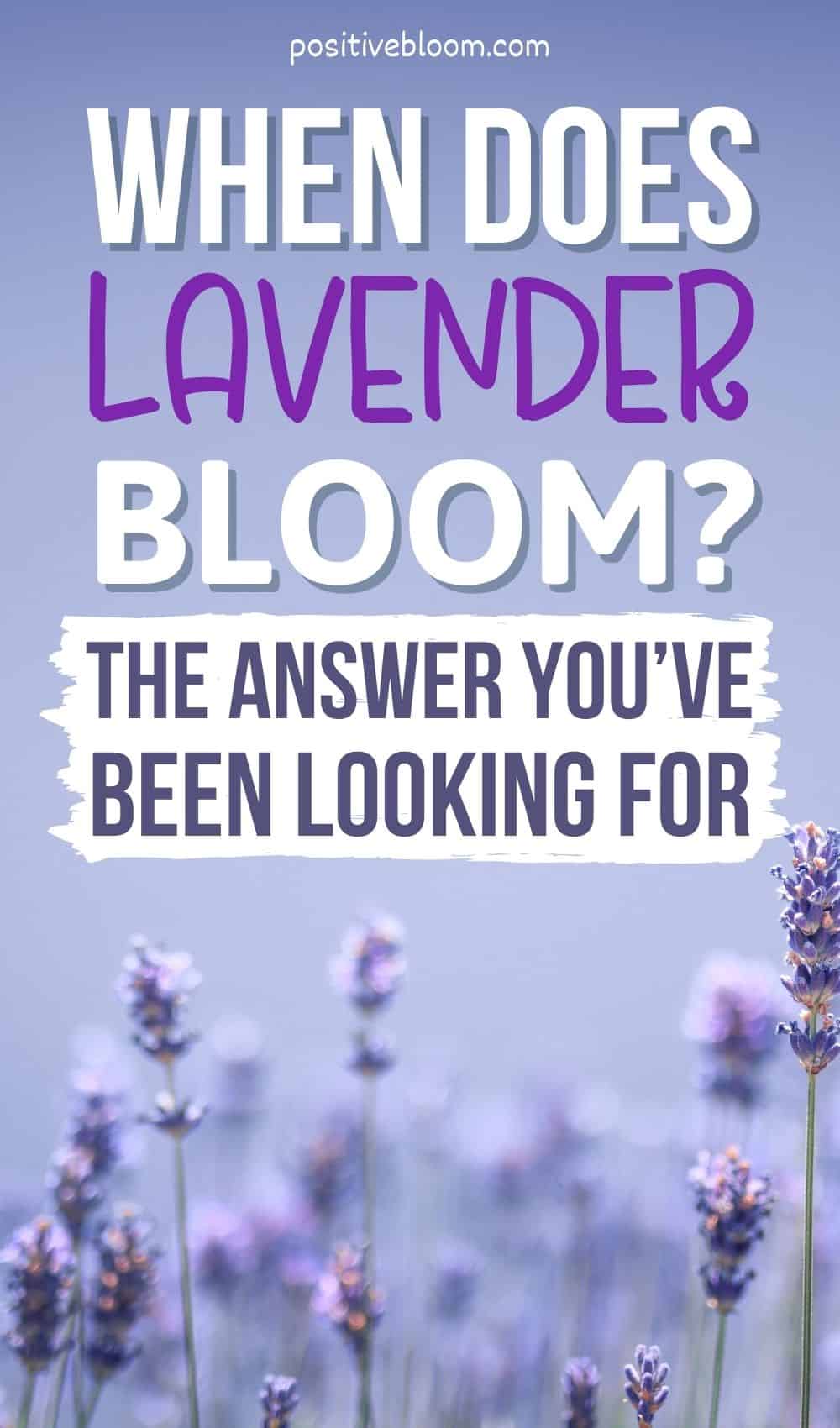Lavender is one of those flowers that takes your breath away every time you see or smell it.
Because we love it so much, we decided to research the answer to “when does lavender bloom?”, So we can help you diffuse its sweet fragrance around your home as soon as possible.
First, the basic information about lavender:
[table id=49 /]This purple flower can bring the ambience of the Mediterranean coast to your home. Once you’ve experienced a variety of lavender, you will never be able to live without it.
This article will teach you the time of blooming for different types of lavender, a short care guide for growing lavender, and the watering schedule that will ensure your plant flowers as much as possible.
When Does Lavender Bloom?
The two most important questions about lavender are: “When does lavender bloom?” and “How can I entice my lavender to bloom?”.
In this section, you will get the answers to both questions and more tips for growing lavender.
Blooming Season Of 4 Main Types Of Lavender
There are four main types of lavender, and not all of them produce flowers at the same time.
In this section, you will find the blooming time of English, French, Spanish, and Portuguese lavender. We also included the time of flowering for the most popular lavender hybrids.
1. English Lavender Blooming Time
The Latin name for English Lavender is Lavandula angustifolia. It is also known as Common lavender or True lavender.
English lavender blooms in early summer, usually in mid-June. It stays in bloom for about four weeks, so you’ll have plenty of time to enjoy its purple flowers.
This variety can also flower in the late summer if you carefully prune it.
The most popular cultivars of English lavender are ‘Munstead,’ ‘Vera,’ and ‘Hidcote.’ They are grown as ornamental houseplants, and are also used for commercial purposes worldwide.
English lavender ‘Munstead’ blooms in spring, earlier than the other cultivars of Lavandula angustifolia.
2. Time Of Blooming Of French Lavender
French lavender is frequently confused with Spanish lavender, and their names are often used interchangeably. However, French lavender is also known as Lavandula dentata.
It blooms in early spring and continues flowering throughout the summer.
The most famous cultivar of this plant is ‘Royal Crown.’ It can bloom all year long if you take care of it well.
3. Flowering Time Of Spanish Lavender
Lavender farms are a truly fascinating sight to experience. The lavender fields in La Mancha should be visited by every gardener. They show that hard work pays off!
When you see those purple fields, you will instantly want to buy as many lavender plants as you can fit in your house, and Spanish lavender would be the perfect choice!
Its Latin name is Lavandula stoechas, but it is also known by its more common names: French lavender (not to be mistaken with Lavandula dentata), Butterfly Lavender, or topped lavender.
This variety may flower from late spring to fall if the conditions are right. Spanish lavender can bloom up to three times a year in climates with mild temperatures: in early May, early to mid-summer (June or July), and early fall.
The most popular cultivars are ‘Regal Splendor,’ ‘Anouk,’ and ‘Ballerina.’
4. Portuguese Lavender Flowering Time
The Latin name of Portuguese lavender is Lavandula latifolia, but it is commonly known as broadleaved and spike lavender.
If the weather conditions allow, it blooms from mid-summer to early fall in June to September.
It is native to western Mediterranean countries where hybridization with English lavender can occur.
Blooming Time Of Hybrid Lavenders
The blooming season of hybrid lavenders is somewhat different from the flowering time of the main species.
This section brings you the three most famous lavender hybrids and their blooming seasons.
Lavandula x Intermedia
Lavandula x intermedia is also known as Lavandin or Dutch lavender. This is a hybrid cross between English and Portuguese Lavender.
This hybrid is less hardy than English lavender, but it produces more flowers that are usually larger than the flowers of the main types.
Also, the cultivars of lavandin tend to bloom later in the season, from July to September. However, each cultivar has a specific blooming time, and we will examine the three most popular.
Phenomenal
Lavandula x intermedia ‘Phenomenal’ blooms a little earlier than other cultivars of lavandin hybrid.
It blooms from mid-summer to early fall, but it flowers earlier in the south where there is more sun. It can often rebloom in late summer or fall, but this is not the only reason it is an excellent choice for your garden.
It can survive lower temperatures in winter, so you won’t have to worry about finding different ways of keeping it safe.
Grosso
Lavandula x intermedia ‘Grosso’ is a variety that blooms in summer. It is also less hardy than the cultivar ‘Phenomenal,’ but it can be perfect for coastal gardens or homes.
Provence
Lavandula x intermedia ‘Provence’ is a variety with many different applications. It is also called ‘Fat lavender.’ It produces flowers from mid- to late summer.
Other cultivars of hybrid lavandin are ‘Impress Purple’ and ‘Seal,’ both of which flower in summer.
Lavandula x Christiana
Lavandula x christiana is a hybrid between Lavandula Canariensis and Lavandula Pinnata.
It blooms in mid-season, but it can bloom in mid-summer, late summer to early fall, and even late fall. It cannot survive temperatures lower than 40°F (4,5°C), but it is still impressive.
This hybrid is also sterile, meaning it cannot produce viable offspring because it doesn’t have functioning ovaries or pollen.
Lavandula x Ginginsii
Lavandula x ginginsii is a hybrid between French lavender and Wooly lavender (Lavandula Lanata). It has only one known cultivar, Goodwin Creek Grey (named after the place it was discovered).
This hybrid is impressive because it starts flowering in early spring and continues even in the winter months when the temperatures are very mild.
Does Lavender Bloom More Than Once?
Lavender often blooms more than once, but it depends on the variety of the plant.
English lavender, for instance, often blooms twice a year: at the beginning and near the end of the blooming season.
Cultivars of lavandin, on the other hand, bloom only once a year, but the flowers last until late summer or early fall. Spanish lavender can flower up to three times a year if the right conditions are met.
The Goodwin Creek Grey variety can flower multiple times, and lavender Christiana can blossom throughout the whole year. It needs protection from winter frost, but other than that it isn’t too tricky to take care of this plant.
French lavender is another variety that blooms more than once a year.
However, if you want to enjoy lavender flowers for more than just a couple of weeks, you have to pay attention to their needs.
You will find our care guide at the end of this article, and if you follow our advice your yard will be purple and fragrant for many years to come.
How Long Does Lavender Stay In Bloom?
Not all varieties of lavender stay in bloom for just a few weeks at a time. It depends on the type and the conditions in which the lavender is grown.
In perfect conditions, English lavender can stay in bloom for three to four weeks, but some cultivars can last until late summer. Spanish lavender flowers usually last up to 3 months, as the cultivars of this type continuously bloom until the very end of the blooming season.
Lavandin typically stays in bloom for two months, until late summer or really early fall.
All these varieties have a long blooming season, but their flowers cannot survive the harsh winter conditions.
French lavender flowers can last a long time, but you must cut off the flower spikes if you want to induce the continued production of flowers.
If the winter temperatures are extremely mild, Lavandula x Ginginsii can stay in bloom for more than six months.
Lavender Application And Benefits
Lavender has many health benefits, and you can use violet or dark purple lavender bracts to make essential oils that help alleviate stress, anxiety, depression, and insomnia. They also have antifungal and antibacterial properties.
You can use them to make sachets and carry them in your purse, or use them as moth repellent in your closets.
Lavender scented soaps and perfumes are always trendy, so we make sure we never lack either.
Short Care Guide
The lavender species all have similar needs. They need plenty of sunlight, a bit of water, and a soil that won’t retain moisture for too long to prosper in any home or yard.
If you want a live hedge that radiates beauty and fragrance, lavender should be your first option.
You know the answer to the question “When does lavender bloom?”, but now is the time to find out what you need to pay attention to in order to get those flowers.
So, let’s begin.
Light Requirements
Lavender needs full sun to produce its stunning flowers and fill your house with its wonderful fragrance.
It can tolerate some shade, but if you want to see it in full bloom you shouldn’t expose it to shade for too long.
You can always invest in good fluorescent grow lights for plants to fight off the shade.
Water And Humidity
Lavender is native to the Mediterranean and is used to dry climates. It is susceptible to overwatering, which may lead to root rot.
The watering needs of lavender are very low. They need to be watered twice a month during their growing season, usually in spring and summer. However, the soil needs to be dry to the touch before being watered.
You don’t need to water them during dormancy as there is plenty of rain and moisture in the ground.
Also, transplanted lavenders require more water because it helps them get over transplant shock.
Humidity
Lavenders love arid climates. They can tolerate some humidity, but high levels can become an issue.
If you live in a more humid environment, you should grow your lavender indoors where humidity is usually lower. However, if you really want a lavender field, you should plant lavenders at some distance to ensure air circulation.
Climate And Temperature
Lavender originated from the Mediterranean, which means they love dry, warm climates. The best care you can offer them is to reflect these conditions.
Ideal temperatures for lavender are between 70 and 75°F (21-23°C), but they can also thrive in temperatures between 68 and 86°F (20-30°C), as that is the average temperature in the Mediterranean.
However, lavender is not fragile. Mature plants can survive temperatures as low as 10°F (-12°C).
Soil And Fertilization
Lavenders prefer alkaline substrates, even though they can tolerate slightly acidic and neutral mediums. They can survive in soil with a pH level between 6.5-8.0.
Also, lavender doesn’t need soil rich in nutrients and organic content. They adapted to the rocky terrain of the Mediterranean, and adding compost to your regular potting mix would just make things worse.
Actually, lavender loves low or moderately fertile alkaline soils. It would be best to add lime to the acidic substrate because this will make the growing conditions perfect for lavender to bloom.
Fertilizer
Lavender doesn’t need to be fertilized. Provide them with at least six hours of sunlight every day, alkaline soil, and a little water, and your job is done.
However, if you want to support their growth with some extra care, you can fertilize it twice a year during their growing season with an all-purpose fertilizer diluted to half-strength.
Should You Use Mulch For Lavender Plants?
Lavender are drought-tolerant plants, so they don’t necessarily require mulching.
However, you can always mulch these flowers, but they require a different medium than your peppers and tomatoes.
Use gravel or sand because they will keep both the lavender and soil warm. Also, you don’t want to smother your plant in mulch because this can lead to root rot and kill the lavender.
Pruning
Pruning is essential for lavender. If you prune them correctly, your lavender will soon decorate your yard or home with beautiful white, pink, purple, or blue blossoms.
Early pruning is the most important thing. If the lavender isn’t pruned within the first two years of its life, there’s a very good chance it will turn woody and end up blooming less.
Remove the new growth after planting, including the flower spikes. It is best to shape it in a circle or a ball within the first year.
The following year it will need more pruning. You need to prune lavender flowers in the spring, which will result in more flowering. Then prune it in the fall, again deadheading the flower spikes so that it can get used to harvesting and shaping.
But don’t worry if you can’t wrap your head around so much information; here’s a video about pruning you can refer to anytime you have doubts or can’t remember something.
Q & A Corner
Believe it or not, there are still some unanswered questions about lavender!
We have found the most common and exciting questions about lavender, and you will find the answers in this section.
Let’s take a look!
Why is my lavender plant not blooming?
The main reason for lavender not blooming is stress. However, the stress for lavender is somewhat different than that of other plants.
Lavender is adapted to arid climates and soils with low amounts of nutrients and organic material. Lavender can get stressed in humid environments and fertile, moist soils.
Also, if you don’t prune your lavender a few times within its first few years, it can get woody and stop producing flowers.
What is the lifespan of a lavender plant?
The lifespan of lavender plants depends on the species, but they can usually live between 5 and 20 years.
Lavender is a perennial, which means you will enjoy their fragrance for many years if you don’t cause it stress and take good care of it.
Gentler varieties can last about five years, whereas hardier lavender species can live for 15 or even 20 years.
What does lavender blooming mean?
Lavender blooms are a stage in the natural growth cycle of lavender. If you follow the prescribed care guide for lavender, it will produce flowers within a year of being planted.
Lavender flowers may signify peace, devotion, purity, silence, and grace. The color purple was the color of aristocracy and royalty, which represents luxury, elegance, and refinement.
Final Thoughts
Now that you know the answer to the question “When does lavender bloom?”, you can get some of your own and start growing these exceptional flowers in your garden.
There are many varieties of lavenders out there, and we wish you good luck in choosing the perfect one. However, if you want a more fragrant species, you should consider getting some cultivars of lavandin.
If you want to have a small lavender field behind your house so that you don’t have to go to France, Spain, Italy, or England to admire this sight, then you can’t go wrong with Spanish lavender cultivars.
Finally, regardless of the variety, lavender has many health benefits and different ways of application. You can spice up your food and help your skin with just one ingredient.
What other plant can do that?
Until next time!
Like this post? Share or pin it for later!



